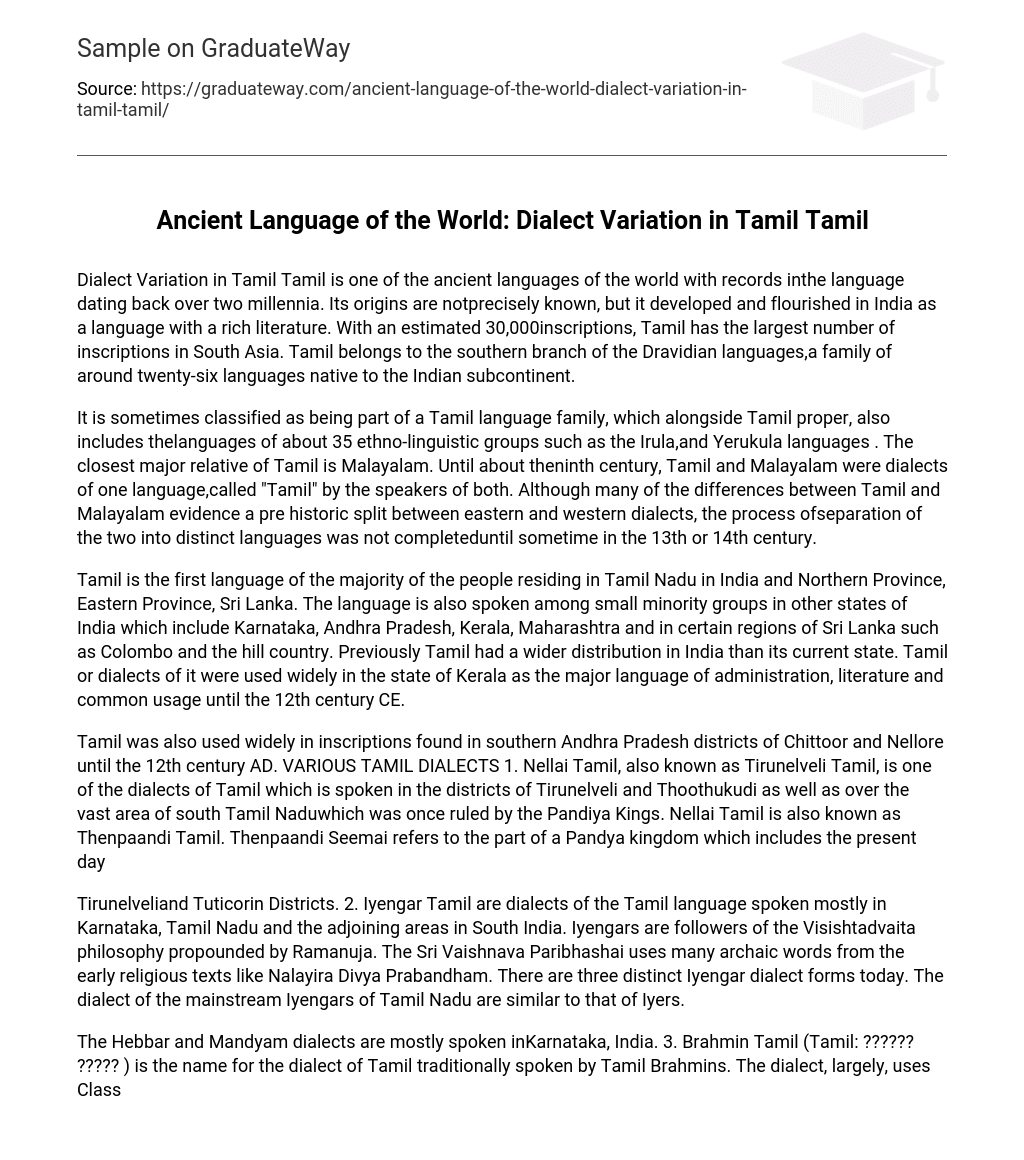Dialect Variation in Tamil Tamil is one of the ancient languages of the world with records inthe language dating back over two millennia. Its origins are notprecisely known, but it developed and flourished in India as a language with a rich literature. With an estimated 30,000inscriptions, Tamil has the largest number of inscriptions in South Asia. Tamil belongs to the southern branch of the Dravidian languages,a family of around twenty-six languages native to the Indian subcontinent.
It is sometimes classified as being part of a Tamil language family, which alongside Tamil proper, also includes thelanguages of about 35 ethno-linguistic groups such as the Irula,and Yerukula languages . The closest major relative of Tamil is Malayalam. Until about theninth century, Tamil and Malayalam were dialects of one language,called “Tamil” by the speakers of both. Although many of the differences between Tamil and Malayalam evidence a pre historic split between eastern and western dialects, the process ofseparation of the two into distinct languages was not completeduntil sometime in the 13th or 14th century.
Tamil is the first language of the majority of the people residing in Tamil Nadu in India and Northern Province, Eastern Province, Sri Lanka. The language is also spoken among small minority groups in other states of India which include Karnataka, Andhra Pradesh, Kerala, Maharashtra and in certain regions of Sri Lanka such as Colombo and the hill country. Previously Tamil had a wider distribution in India than its current state. Tamil or dialects of it were used widely in the state of Kerala as the major language of administration, literature and common usage until the 12th century CE.
Tamil was also used widely in inscriptions found in southern Andhra Pradesh districts of Chittoor and Nellore until the 12th century AD. VARIOUS TAMIL DIALECTS 1. Nellai Tamil, also known as Tirunelveli Tamil, is one of the dialects of Tamil which is spoken in the districts of Tirunelveli and Thoothukudi as well as over the vast area of south Tamil Naduwhich was once ruled by the Pandiya Kings. Nellai Tamil is also known as Thenpaandi Tamil. Thenpaandi Seemai refers to the part of a Pandya kingdom which includes the present day
Tirunelveliand Tuticorin Districts. 2. Iyengar Tamil are dialects of the Tamil language spoken mostly in Karnataka, Tamil Nadu and the adjoining areas in South India. Iyengars are followers of the Visishtadvaita philosophy propounded by Ramanuja. The Sri Vaishnava Paribhashai uses many archaic words from the early religious texts like Nalayira Divya Prabandham. There are three distinct Iyengar dialect forms today. The dialect of the mainstream Iyengars of Tamil Nadu are similar to that of Iyers.
The Hebbar and Mandyam dialects are mostly spoken inKarnataka, India. 3. Brahmin Tamil (Tamil: ?????? ????? ) is the name for the dialect of Tamil traditionally spoken by Tamil Brahmins. The dialect, largely, uses Classical Tamil and has an extremely high proportion of Sanskrit words compared to spoken dialects used by the non-Brahmin Tamils. [1][2] According to linguist V. Balasubramaniam, Brahmin Tamil dialect is closest to the Central Tamil dialect, particularly, the variant used by Vellalars and Mudaliyars. 3] There are many forms of Brahmin Tamil spoken. While the Tamil spoken by Brahmins vary from place to place influenced by the regional dialect of Tamil used, Brahmin Tamil, in general is lesser influenced by regional dialects that the dialects used by other Tamil communities. [8] The two main regional variations are Thanjavur and Palakkad sub-dialects. 4.. Madras Tamil, is a colloquial slang of Tamil language spoken in the city of Chennai, India(previously known as Madras). The word bashai derives from the Sanskrit bhasha (language).
Like Bambaiya Hindi used in Mumbai, Madras Bashai is a loose polyglot blend of Tamil with Indian English, Telugu and Hindustani. Madras bashai has been largely popularized by autorickshaw drivers and fishermen from the northern parts of the city. 5. The Sri Lankan Tamil dialects or Ceylon Tamil dialects form a group of Tamil dialects used in the modern country of Sri Lanka by Sri Lankan Tamil people that is distinct from the dialects of modern Tamil spoken in Tamil Nadu and Kerala states of India.
Tamil dialects are differentiated by the phonological changes andsound shifts in their evolution from classical or Old Tamil (300 BC – 700 CE). It is broadly categorized into three sub groups: Jaffna Tamil, Batticaloa Tamil andNegombo Tamil dialects. These dialects are also used by ethnic groups other than Tamils such as Sinhalese people, Sri Lankan Moors and Veddas, who consider them to be distinct. 6.
The Central Tamil dialect is a dialect of Tamil spoken in the districts of Thanjavur, Tiruvarur, Nagapattinam and Tiruchirapalli in central Tamil Nadu, India and to some extent, in the neighbouringCuddalore and Pudukkottai districts. [1][2]Along with Madurai Tamil, the Central Tamil dialect is considered to be one of the purest forms of spoken Tamil and is considered to be the basis of standard spoken Tamil. [3][4] Of the different Tamil dialects, the Central Tamil dialect bears the closest affinity to Brahmin Tamil[5] (particularly the variant used by the upper caste Vellalars andMudaliyars). [2]





